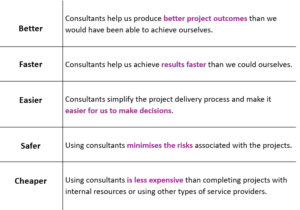What is value, and why don’t clients think they are getting it?
Clients consistently talk about value. Convincing a client that you can create or deliver it is a key factor in winning new work. But are firms successful? And what is value, anyway?
No buyer is going to part with their money for something they don’t think is going to add value for them in some form—and that applies to consulting just as much as a house renovation or a laptop. But what that value actually is, when it comes to consulting, is notoriously hard to pin down. Clients may be in broad agreement that they need to be able to measure the value-add of consulting in financial terms, but there’s little consensus when it comes to the underlying value-add that generates those financial returns. And even within one client organisation, different stakeholders in a project can have opposing views on what constitutes value in their eyes.
Previous research we’ve carried out has looked at the ways in which consultants enhance the project delivery process. Those who can be genuinely said to be adding value are those who enable a client to tackle a problem in a way that is different to how they would have tackled the problem on their own. We can group these areas of differentiation into five dimensions, as below, which helps in defining what value is.

Does this help us to understand what clients want when it comes to value? Not entirely…
We’ve often written about the value gap—the disparity between the proportion of clients who believe the quality of the solution they are getting is high and the proportion who believe they are getting a return on their investment that is greater than the fees spent. This gap has been persistent for as long as we’ve been gathering data and has widened in 2024.
Should we interpret this as firms failing to deliver value as they used to? We don’t think so. While fewer clients believe that the results of consulting work are adding up to more than the cost incurred, this is more likely to be down to increased scrutiny of costs in today’s uncertain economic environment and a corresponding increased focus on value.
But one additional reason for the dampened perceptions could be the fundamental difference between how clients and firms think about value. Historically, firms have tended to focus on one particular dimension, and to describe how the act of using a team of consultants would add value: A technology implementation might achieve “cheaper” results because using consultants would avoid the need to hire or train staff for a one-off task. A product innovation project may add value by being “faster”, enabling a speedy response to competitive pressures. This focus on adding value through engaging consultants made sense. It simplified the concept of value and made sure that everyone was aiming towards a similar goal.
However, that’s not how clients look at value. They tend to be focused on the end results—the value that is created as a result of the project—rather than the benefits of using consultants to achieve them. Firms themselves have started to align their pitches to this model of value creation, too. Through this lens, the technology implementation work is viewed as creating value by making future processes “simpler” or “cheaper”, for example, while the innovation project does so by creating a “better” product. And this makes it harder to see the value as being greater than the fees paid. Yes, the product is better, or the future processes cheaper, but this view doesn’t capture the reasons for consultants being used in the first place.
A recent conversation with a client centered around exactly this point. Discussing AI, the client didn’t want to choose between the value added by the consulting process, and the value created after it had finished—they wanted to see both. And this is where firms could be getting value very wrong. Too much focus on one dimension means that gains elsewhere are overlooked. And focusing on the process rather than the end point means that firms are talking in a different language to their clients. If firms can articulate more clearly all the areas of value they can achieve, we might start to see that gap closing in 2025.